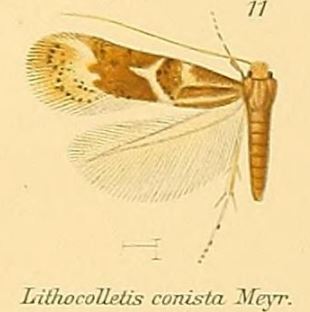
Acacia saligna, commonly known by various names including coojong, golden wreath wattle, orange wattle, blue-leafed wattle, Western Australian golden wattle, and, in Africa, Port Jackson willow, is a small tree in the family Fabaceae. Native to Australia, it is widely distributed throughout the south west corner of Western Australia, extending north as far as the Murchison River, and east to Israelite Bay. The Noongar peoples know the tree as Cujong.

Acacia, commonly known as the wattles or acacias, is a large genus of shrubs and trees in the subfamily Mimosoideae of the pea family Fabaceae. Initially, it comprised a group of plant species native to Africa and Australia.

Gracillariidae is an important family of insects in the order Lepidoptera and the principal family of leaf miners that includes several economic, horticultural or recently invasive pest species such as the horse-chestnut leaf miner, Cameraria ohridella.

The Sunrise Dam Gold Mine is located 55 km south of Laverton, Western Australia, on the eastern margin of Lake Carey. It is fully owned by AngloGold Ashanti and comprises a large-scale mechanized underground mine with a conventional gravity and leach process plant. In 2015 the mine accounted for 5% of the company's production.

Acrocercops alysidota is a moth of the family Gracillariidae. It is known from New South Wales, Queensland, Victoria, Southern Australia and Western Australia as well as New Zealand.

Acrocercops chionosema is a moth of the family Gracillariidae. It is known from Queensland and New South Wales, Australia.
Acrocercops antimima is a moth of the family Gracillariidae. It is known from New South Wales, Australia.
Acrocercops didymella is a moth of the family Gracillariidae. It is known in Australia from the states of New South Wales, Victoria, South Australia and Western Australia.
Acrocercops eupetala is a moth of the family Gracillariidae. It is known from New South Wales and Queensland, Australia.
Caloptilia octopunctata is a moth of the family Gracillariidae. It is known from the Democratic Republic of Congo, Tanzania, Uganda, South Africa, India, Australia, New Zealand and Indonesia.
Conopomorpha heliopla is a moth of the family Gracillariidae. It is known from the Australian states of Tasmania, Queensland and Western Australia.
Cuphodes profluens is a moth of the family Gracillariidae. It is known from Australia, India (Bihar) and Pakistan.
Epicephala australis is a moth of the family Gracillariidae. It is known from Queensland, Australia.
Polysoma eumetalla is a moth of the family Gracillariidae. It is known from the Australian states of Queensland, New South Wales, South Australia, Tasmania and Victoria and from New Zealand.

Phyllonorycter conista is a moth of the family Gracillariidae. It is known from India (Bihar), Malaysia (Pahang), Nepal, the Philippines and Sri Lanka.
Metriochroa fraxinella is a moth of the family Gracillariidae. It is known from Japan.
Metriochroa syringae is a moth of the family Gracillariidae. It is known from Hokkaido island in Japan.
Metriochroa symplocosella is a moth of the family Gracillariidae. It is found in Hunan, China.
Uromycladium is a genus of rust fungi in the family Pileolariaceae. It was circumscribed by mycologist Daniel McAlpine in 1905. The genus was established by McAlpine for rusts on Acacia with teliospores that clustered at the top of a pedicel.

Uromycladium tepperianum is a rust fungus that infects over 100 species of Acacia and related genera including Paraserianthes in Australia, south-east Asia, the south Pacific and New Zealand. The acacia gall rust fungus species Uromycladium tepperianum has been introduced to South Africa as a biological control on the invasive Australian shrub Acacia saligna.





